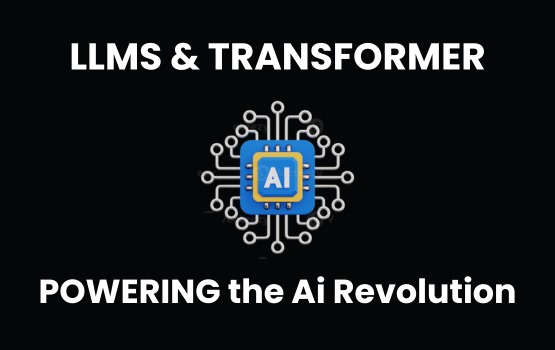
Large Language Models (LLMs) and Transformers: Powering the AI Revolution
In recent years, Large Language Models (LLMs) have become one of the most exciting breakthroughs in artificial intelligence. They are the engines behind advanced applications like ChatGPT, Google Bard, and many other AI-powered tools. At the heart of these models lies a key innovation called the Transformer architecture, which has transformed the way machines understand and generate human language.
What are LLMs?
Large Language Models (LLMs) are deep learning models trained on massive amounts of text data. Their primary function is to predict the next word in a sequence, but through this simple mechanism, they develop the ability to:
- Generate human-like text
- Translate between languages
- Summarize information
- Answer questions
- Assist in coding, analysis, and creative writing
The “large” in LLM refers not only to the vast size of the datasets but also to the number of parameters (often in the billions or even trillions) that allow them to capture complex patterns of language.
The Role of Transformers
Before Transformers, earlier models like RNNs (Recurrent Neural Networks) and LSTMs (Long Short-Term Memory) were used for natural language processing. However, they struggled with long-term dependencies—remembering information across long sentences or documents.
The Transformer model, introduced by Vaswani et al. in the 2017 paper “Attention is All You Need”, solved this problem through a mechanism called self-attention.
Key Features of Transformers:
- Self-Attention Mechanism – Allows the model to weigh the importance of different words in a sentence, regardless of their position.
- Example: In the sentence “The cat that chased the mouse was hungry”, the word “cat” is correctly linked to “was hungry”.
- Parallelization – Unlike RNNs, transformers process all words in a sentence simultaneously, making training much faster.
- Scalability – Transformers can be scaled to massive sizes, enabling the creation of today’s LLMs.
LLMs + Transformers: Why They Matter
The combination of LLMs and Transformers has led to AI systems that are:
- Highly accurate in understanding context
- Flexible across domains (law, medicine, education, business, etc.)
- Creative, capable of producing original text, poetry, code, and even design ideas
These models are not limited to text; the same architecture powers multimodal systems that can process images, audio, and even video, opening up endless possibilities.
Challenges and Considerations
While powerful, LLMs and Transformers also raise important challenges:
- Bias in data – They may replicate or amplify human biases present in training data.
- High resource cost – Training requires enormous computing power and energy.
- Hallucination – Sometimes, models generate information that sounds correct but is factually inaccurate.
Addressing these issues is crucial to ensuring responsible and ethical AI development.
Conclusion
Large Language Models and Transformers represent a major leap in artificial intelligence. By enabling machines to understand and generate language at an unprecedented scale, they have revolutionized communication, business, research, and creativity. As the technology continues to evolve, striking a balance between innovation, efficiency, and responsibility will be the key to unlocking its full potential.
In recent years, Large Language Models (LLMs) have become one of the most exciting breakthroughs in artificial intelligence. They are the engines behind advanced applications like ChatGPT, Google Bard, and many other AI-powered tools. At the heart of these models lies a key innovation called the Transformer architecture, which has transformed the way machines understand and generate human language.
What are LLMs?
Large Language Models (LLMs) are deep learning models trained on massive amounts of text data. Their primary function is to predict the next word in a sequence, but through this simple mechanism, they develop the ability to:
- Generate human-like text
- Translate between languages
- Summarize information
- Answer questions
- Assist in coding, analysis, and creative writing
The “large” in LLM refers not only to the vast size of the datasets but also to the number of parameters (often in the billions or even trillions) that allow them to capture complex patterns of language.
The Role of Transformers
Before Transformers, earlier models like RNNs (Recurrent Neural Networks) and LSTMs (Long Short-Term Memory) were used for natural language processing. However, they struggled with long-term dependencies—remembering information across long sentences or documents.
The Transformer model, introduced by Vaswani et al. in the 2017 paper “Attention is All You Need”, solved this problem through a mechanism called self-attention.
Key Features of Transformers:
- Self-Attention Mechanism – Allows the model to weigh the importance of different words in a sentence, regardless of their position.
- Example: In the sentence “The cat that chased the mouse was hungry”, the word “cat” is correctly linked to “was hungry”.
- Parallelization – Unlike RNNs, transformers process all words in a sentence simultaneously, making training much faster.
- Scalability – Transformers can be scaled to massive sizes, enabling the creation of today’s LLMs.
LLMs + Transformers: Why They Matter
The combination of LLMs and Transformers has led to AI systems that are:
- Highly accurate in understanding context
- Flexible across domains (law, medicine, education, business, etc.)
- Creative, capable of producing original text, poetry, code, and even design ideas
These models are not limited to text; the same architecture powers multimodal systems that can process images, audio, and even video, opening up endless possibilities.
Challenges and Considerations
While powerful, LLMs and Transformers also raise important challenges:
- Bias in data – They may replicate or amplify human biases present in training data.
- High resource cost – Training requires enormous computing power and energy.
- Hallucination – Sometimes, models generate information that sounds correct but is factually inaccurate.
Addressing these issues is crucial to ensuring responsible and ethical AI development.
Conclusion
Large Language Models and Transformers represent a major leap in artificial intelligence. By enabling machines to understand and generate language at an unprecedented scale, they have revolutionized communication, business, research, and creativity. As the technology continues to evolve, striking a balance between innovation, efficiency, and responsibility will be the key to unlocking its full potential.
Leave a Reply